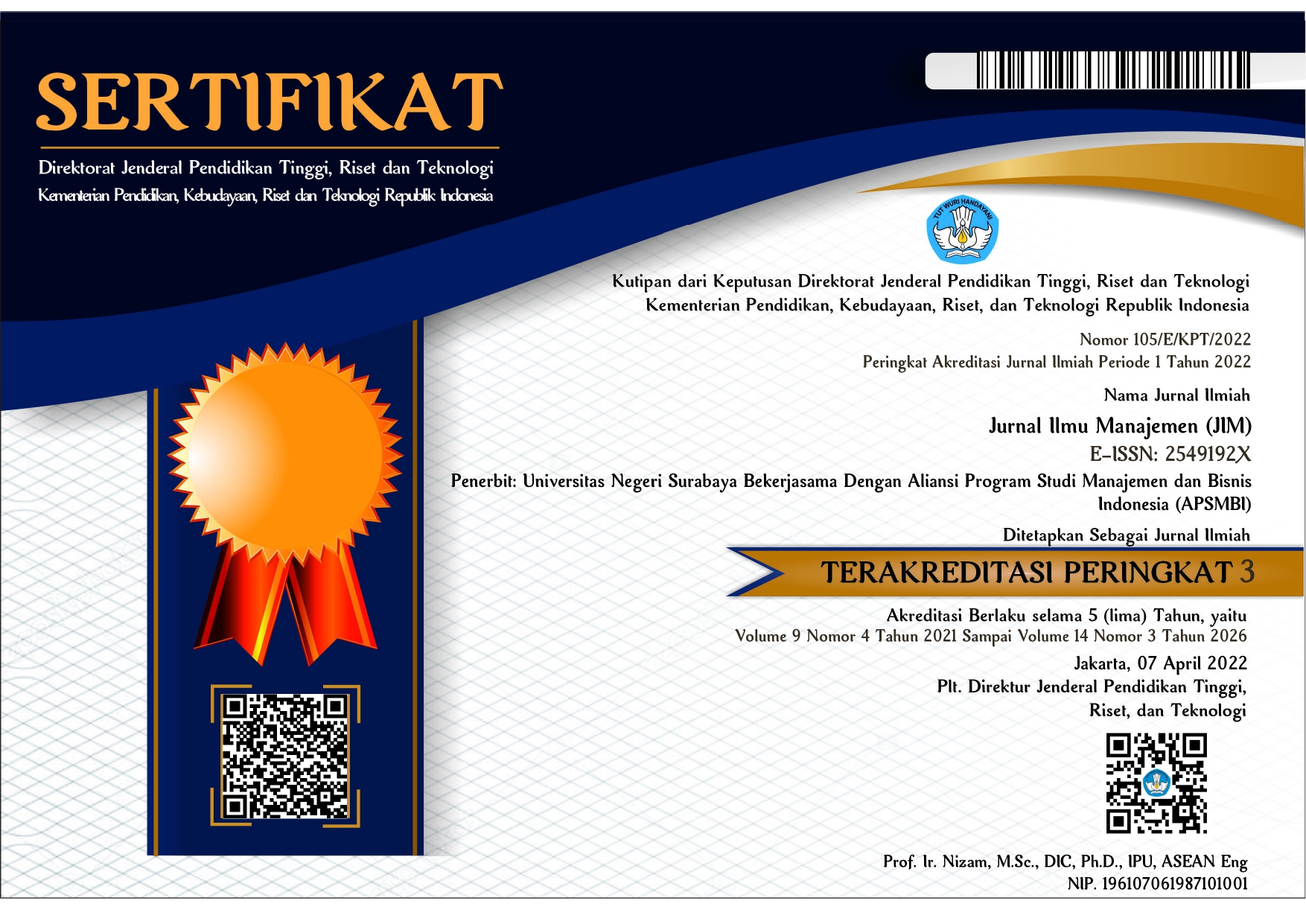Pengaruh Dinamisme Lingkungan dan Ketidakpastian Lingkungan terhadap Kinerja UMKM
DOI:
https://doi.org/10.26740/jim.v10n3.p902-910Keywords:
dynamic capability, environmental uncertainty, micro small medium enterprises (MSMes), performanceAbstract
Micro, Small, and Medium Enterprises (MSMEs) face various challenges from rapidly changing changes. One of the challenges in maintaining and building MSME performance is being able to go through environmental dynamism and environmental uncertainty. This study aims to examine and analyze the relationship between environmental dynamism and environmental uncertainty on the performance of SMEs. Environmental dynamism is measured using customer, competitor, government, and environmental dimensions. Environmental uncertainty includes technological developments, consumer preferences, competitor behavior, disloyal customers, unreliable suppliers, and financial shortages, and MSME performance indicators consist of sales growth, product quality, and product development. Data analysis techniques using PLS-SEM analysis. The selected sample in this study consisted of 100 owners or managers of MSMEs in Mojokerto, Indonesia. The results showed that environmental dynamism and environmental uncertainty had a significant positive effect on the performance of MSMEs. The implication of this research is that environmental uncertainty is not an obstacle to improving MSME performance. Good adaptability is the key for MSMEs to be able to survive in difficult condition.
References
Abdallah, L., & Persson, M. (2014). The Effect of Environmental Uncertainty Conditions on Organisational Innovativene ss and Performance of SMEs.
BPS. (2019). Produk Domestik Regional Bruto Kabupaten/Kota di Provinsi Jawa Timur (p. 120). https://jatim.bps.go.id/publication/2020/12/17/0ee19b4e545a453921bfc18b/produk-domestik-regional-bruto-kabupaten-kota-di-provinsi-jawa-timur-menurut-pengeluaran-2015-2019.html
Ghozali, I. (2018). Aplikasi Analisis Multivariate dengan Program IBM SPSS 25 (9th ed.). Badan Penerbit Universitas Diponegoro.
Haleem, F., Jehangir, M., & Haq, Z. U. (2018). Link between Environmental Dynamism and Firm Performance: The role of Strategic Planning. Journal of Managerial Sciences, August 2019.
Li, D.Y., & Liu, J. (2014). Dynamic Capabilities, Enviromental Dynamism, a nd Competitive Advantage: Evidence from China. Journal of Business Research, 67 , 2793 - 2799.
Mukherji, A., & Mukherji, J. (2016). Environmental Uncertainty and Positive Performance of Small Firms: The Roles of Key Mediators. Academy of Management Proceedings, 2016(1), 10437. https://doi.org/10.5465/ambpp.2016.10437abstract
Purnama, Chamdan & Subroto W.P. 2016.Competition Intensity, Uncertainty Environmental on the use of Information Technology and its Impact on Business Performance Small and Medium Enterprises.International Review of Management and Marketing.Vol. 6(4): 984-992.
Rahman, M. F. W., Kistyanto, A., & Surjanti, J. (2022). Does cyberloafing and person?organization fit affect employee performance? The mediating role of innovative work behavior. Global Business and Organizational Excellence, 41(5), 1-21.
RI. (2008). Undang-Undang No. 20 tentang UMKM.
Sandra, A., & Purwanto, E. (2015). Pengaruh Faktor-Faktor Eksternal dan Internal Terhadap Kinerja Usaha Kecil dan Menengah di Jakarta. Business Management, 11(1), pp.97-124. https://www.e-jurnal.com/2014/11/analisis-faktor-faktor-yang_24.html
Sekaran, U. and Bougie, R. (2016), Research Methods for Business: A Skill-Building Approach, 7th ed., John Wiley & Sons, Chichester
Timilsina, Binod. 2016. Does competitively distinct operation enable Performance in turbulent business environment? A study on finish SMEs.Management and Production Engineering Review.Vol. 7 No.3: 94-104.
Downloads
Published
How to Cite
Issue
Section
License

This work is licensed under a Creative Commons Attribution-NonCommercial 4.0 International License.
 Abstract views: 1399
,
Abstract views: 1399
, PDF Downloads: 1543
PDF Downloads: 1543










